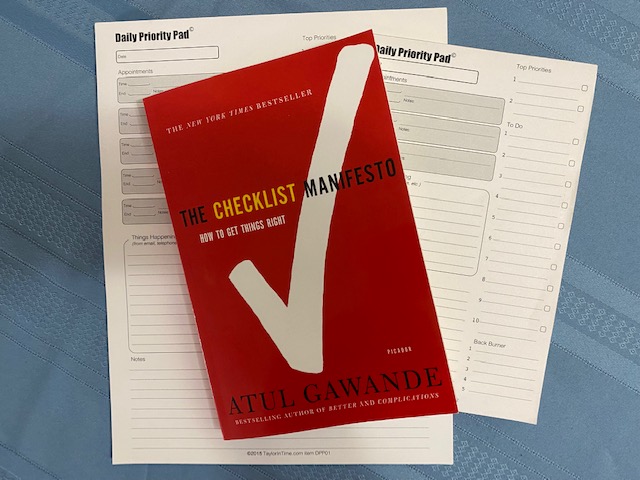Thanks in part to Atul Gawande’s book, “The Checklist Manifesto: How to Get Things Right,” the checklist is making a comeback. Like David and Goliath, the lowly checklist has come forward to challenge the troublesome side of technology.
The troublesome side of technology is its vast capabilities made possible through speed and complexity. Communication at lightning speed. Instant messages. One-click purchases. Pop-up ads. Computerized phone calls. Online meetings. You can be on the receiving end of hundreds of emails, text messages, and voice calls daily. Day or night.
Today, it’s almost impossible to avoid potential interruptions while working – not because of the technology – but because of our inability to cope with it. If we were machines, we would have no problem. But we are humans. We think and feel and react. Unlike machines, we require sleep and food and physical exercise and fresh air and companionship to function.
We try to keep up with technology on its terms, working faster and longer and trying to do several things at the same time. And we are further burdened by our humanity since we have a fear of missing out on something desirable. This is referred to by some as FOMA. This fear makes us vulnerable to technology-enabled interruptions, and the allure of social media. We don’t want to miss out on something fundamentally important that others are experiencing now.
Plus, as Gawande points out in his book, unlike computers, we cannot possibly remember everything. And there are so many things to remember these days. Despite intense training and personal competence, airplanes have crashed due to pilot error and patients have died due to surgeon error. And the most effective strategy for preventing this is a checklist. Not a memorized checklist, since memory can fail under stress.
In business, death occurs as well. That’s why there are checklists for preventive maintenance, and safety procedures for operating equipment. And errors in the office can cause lost time, decreased productivity, higher costs, missed deadlines, and so on. That’s why there are checklists for things to do and when to do them.
In our personal lives we have checklists in the form of grocery lists, things to do and buy, people to call, cards to mail, and so on.
Getting back to Gawande’s book, it’s an eye-opening look at the lifesaving potential of checklists. For example, a simple checklist of five things to do to avoid infections in one hospital prevented 43 infections and eight deaths and saved $2 million in costs.
The checklist has always been with us. But people tend to drift away from it at a time when it is needed the most. Our brains can only handle so many things at once. And with today’s busyness and complexity, exacerbated by technology, it is essential.
So, I hope I’m right when I suggest that the checklist is making a comeback. But I also hope that checklists are not seen as the solution to the preponderance of interruptions that we experience. Checklists only prevent us from forgetting. Note that early in this article I refer to them as “potential” interruptions while we are working. We seldom need to be interrupted from our deep work as explained in an earlier article. These potential interruptions are delayed until we are ready for them.
To cope with the interruptions, refer to the earlier blog article, How Interruptions Impact your Productivity.


Recent Comments